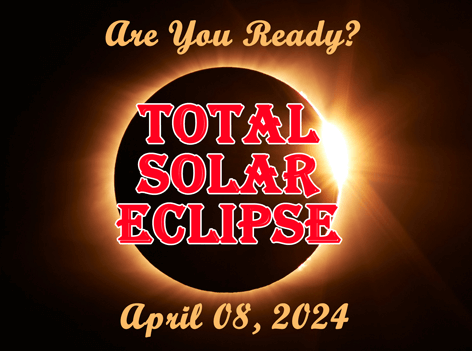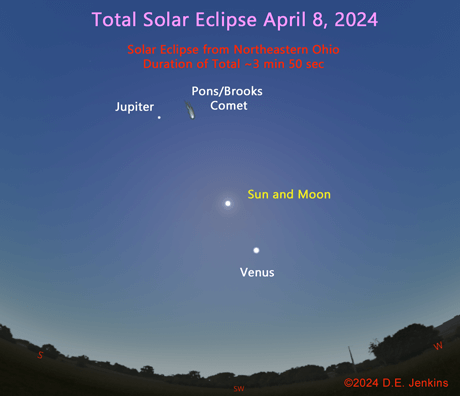
April 2024 - Vol. 28, No. 4
This Month's Night Sky - NOTE: The next paragraph describes the sky as it appears at 10 pm EST (11 pm EDT) near mid- month. The sky also looks this way at 11 pm EST (midnight EDT) during the beginning of the month and at 9 pm EST (10 pm EDT) by month's end.
As the days lengthen, the stars of the Winter Triangle fade into evening's dusk. The "Big Dipper" asterism (Ursa Major) is well placed for viewing this month since it is almost directly overhead. Follow the curve of its handle to Arcturus (Bootes) and continue on the curve to Spica (Virgo). Regulus (Leo) is on the ecliptic (the path traced by the planets and Moon), just W. of overhead. Further West, on the ecliptic, find the Gemini Twins, Castor and Pollux, and finally the Pleiades star cluster, an asterism of Taurus.
MERCURY reaches inferior conjunction on April 11. VENUS disappears from the morning sky this month, heading for superior conjunction in June. MARS continues to rise in the morning sky, still separating from the Sun, it shines at 1.2 mag. JUPITER fades in the evening sky preparing for conjunction with the Sun next month. SATURN rises slowly in the early morning sky. URANUS lost in the Sun by the end of the month. NEPTUNE begins to emerge in the morning twilight, for those with telescopes.
Review how to determine Angular Measurement.
Calendar of Events
NOTE: For those observers not in the ET zone, convert the calendar times to your zone's time by subtracting one hour for CT, two for MT and three for PT. Don't forget to adjust for Daylight Savings Time when necessary by subtracting one hour from your planisphere's time. Dawn and dusk times must also be corrected. See your local newspaper, TV news, or cable TV's Weather Channel for sunrise and sunset times or check with the U.S. Naval observatory. Unfortunately some of these events may occur during daylight hours in your area.
| DATE | EVENT |
| 01 | Mercury stationary. |
| 06 |
Mars 2 deg. N. of Moon. Saturn 1.2 deg. N. of Moon, occultation from Antarctic, Kerguelen Is., Marion Is. |
| 07 |
Neptune 0.4 deg. N. of Moon, occultation from S. Georgia and S. Shetland I, Marion Is., SE Africa, W. Indonesia Venus 0.4 deg. N. of Moon, occultation from E. Polynesia, Galapagos Is., parts of N. America, S. Greenland, Iceland, Azores, Ireland. Moon at perigee, expect large tides. |
| 8 | Total solar eclipse over North America. See the article on this page or check out the April 8, 2024 Total Solar Eclipse page from Astra's Eclipse Guide. |
| 10 |
Venus at greatest heliocentric lat. S. Jupiter 4 deg. S. of Moon |
| 11 |
Moon 0.4 deg. S. of the Pleiades (M-45). Mercury in inferior conjunction Mars 0.5 deg. N. of Saturn. Mars at greatest heliocentric longitude S. |
| 15 | Alpha Geminorum, Pollux, 1.5 deg. N. of Moon. |
| 20 |
Moon at apogee. Jupiter 0.5 deg. S. of Uranus |
| 22 | Lyrid Meteor peak. The shower is estimated to contain 20 meteors at peak, this year the Moon is near first quarter and should not interfere with observing. |
| 23 |
This month's full Moon is often called the "Pink Moon" after a specific spring flower, phlox subulata, sometimes called "pink moss." Alpha Virginis, Spica 1.4 deg. S. of Moon. Should be a rather nice conjunction. |
| 24 | Mercury stationary. |
| 26 | Alpha Scorpii, Antares, 0.3 deg. S. of Moon, occultation from NE Africa, parts of the Middle East, S. India, Indonesia, most of the Philippines, NW Australia, Extreme W. Micronesia and W. Polynesia. |
| 29 | Mars 0.4 deg. S. of Neptune, during morning twilight. You will need a telescope and must beat the Sun. |
| 30 | Mercury at aphelion. |
Lunar Almanac for April 2024
| Phases of the Moon | Phase and Date(s) | Best viewed before local midnight |
 |
New 08 |
Deep Space Objects |
 |
1st. Qtr 15 |
Planets & Moon |
 |
Full 23 |
Moon |
 |
Last Qtr 02 |
Deep Space & Planets |
Total Solar Eclipse - April 8, 2024

North America is once again graced with a total solar eclipse, passing through some of the areas that an eclipse path crossed through the United States in August of 2017. The weather is iffy all along the eclipse, but when did that ever stop us crazy eclipse chasers? If you are near the centerline, do what it takes to get outside. Don't wait for pristine weather conditions. Even if the Sun is totally blocked with clouds, if you are on the centerline, you will be plunged into darkness when the Moon blocks out the disk of the Sun.
This eclipse is guaranteed to be an exciting one, because the Sun is nearing solar maximum, when the disk is covered with lots of sunspots and other solar events such as prominences and flares. The solar corona would be fantastic if the solar weather we've been tracking is any indicator.
At Astra's Stargate, we host an Eclipse Guide. Our Eclipse Home page has basic information on eclipses in general. Pages for Solar and Lunar eclipses give great detail on these events. The April 8, 2024 Eclipse and the April 2024 Eclipse Resources pages give the eclipse details and present a tiny sliver of the pages out there on this upcoming event. The April 2024 pages can help you find resources to assist with planning. If you are planning a party, the 2024 Eclipse Party guide may help you out. If you don't have equipment, use the Eclipse Safety page to find instructions on making a safe, pinhole projection device.
The American Astronomical Society has an app that presents the Google Interactive Map for Solar Eclipses that Xavier Jubier maintains for iPhones and Androids. The app is called, Totality and can be downloaded for free.
On April 8, 2024, the path of a total solar eclipse (Saros 139) emerges from the Pacific Ocean and enters Mexico near Mazatlan. Greatest eclipse occurs at Nazas, Mexico where it lasts for 4m 28s. It crosses into the United States, first encountering the State of Texas near Eagle Pass, Texas. It passes through Texas, Oklahoma, Arkansas, Missouri, Illinois, Indiana, Ohio, where it enters Lake Erie, Pennsylvania, and New York. It crosses Lake Ontario, returning to New York, Vermont, grazing New Hampshire, it goes back into Canada. The central path also passes through Maine in the U.S. and New Brunswick in Canada. The eclipse path will plunge into the Gulf of St. Lawrence returning to land at Newfoundland, plunge into the north Atlantic and stop below Iceland, unable to make it to Europe.
What's in the Sky for the April 8 Total Solar Eclipse
The image below comes from the Stellarium planetarium program. It was programmed for northeastern Ohio, but these results will be similar in your own sky at the time of totality. For this eclipse we are fortunate to be treated to the spectacle of a very nice periodic comet that is heading for its perihelion date with the Sun. Comet 12P/Pons-Brooks has been quite active so far for this visit to the inner solar system, a visit that occurs once every 71.3 years. Perhaps when the Moon covers the Sun completely, sharp eyes and cameras can spot the comet near Jupiter. Brighter, but closer to the horizon, Venus may also be seen.

Do not wait for the day of the eclipse. Get out your equipment if you are an amateur astronomer. Dust off that solar filter and give it a whirl on the Sun in advance. Now would be a good time. The more familiar you are with your equipment and the place you are setting up, the easier it is to observe while totality is demanding all your attention.
--See You Under the Stars, uh, Sky!
Astra for Astra's Almanac
This installment of "What's Up?" is ©2024 by Dawn Jenkins for Astra's Stargate. View Ron Leeseburg's Farewell Issue for information on where to find information such as is presented in this almanac.